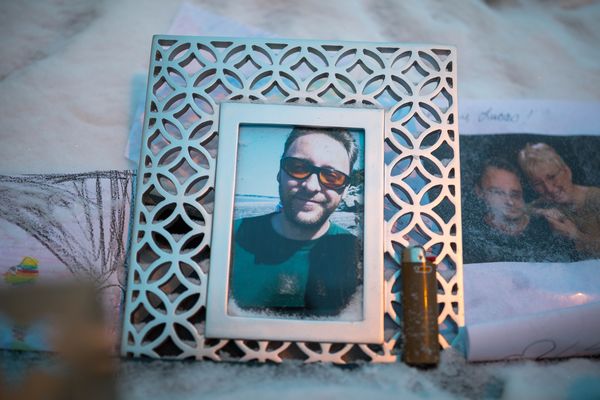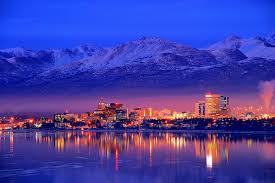
ANCHORAGE IN THE SHADOW OF UNSOLVED HOMICIDES

“Alaska itself is an unusual state”
-Fareed Zakaria
John Muir once wrote that Alaska is one of the most wonderful countries in the world, to the lover of the wilderness. This is the American largest state and the pearl of natural beauty and wildlife. It has simply everything, from the dangerous mountains for climbing, rivers to raft and hidden waterfalls and glaciers to explore, to the amazing animals that are born to be free and captured in the unforgettable camera shoots.

But, behind the perfection, there is something else that eats up slowly the peace on the surface of Alaskan life. Something dark and evil, something that can not be caught and stopped, something that turns life of police officer John Carpenter into the night mare. John is 40 years old but almost 18 years devoted to the law enforcement in Anchorage. He has seen so many bad things that there are moments when he thinks he is 100 years old. When we look at him, the son of the Steve and Maria Carpenter, the beloved husband of Frances and lovely father of Daniel, we think that his energy and colors of life are gone.Tall and muscled , with white and rough skin and long dark blond hair, he looks more like a lost viking than like one of the best detectives Alaska has ever had. But even John knows that age of the happiness is gone and that there is now age of sadness, for all victims and their undiscovered killers.

According to the latest police reports, Alaska has one of the highest violent crime rates in the U.S. Just to remind, based on FBI statistic from 2012, it was 603.2 violent crimes per 100,000 compared to the national average of 386,9 for 2012. But, in 2016, the violence has escalated. In Anchorage, 34 of people were killed by homicide and only three of the cases have been solved. It is not about drug gangs anymore, it is about all bad you can imagine that could happen somewhere. Rapes, horror serial killers. child molestors, kidnappers, in other words, the worst social predators have found their paradise in Alaska and they do not give up to harvest their souvenirs.

The problem over there is the absence of any law enforcement in at least 75 Native American Alaskan villages. That opens the door for the crimes. The growing problem of alcoholism and appetite for sexual offend and drugs abusement are making a collage of hell for the residents that are affected with this epidemics of evil. Many are simply geographically and administrative isolated and all protection is one they get, when they report, from the Alaska State Troopers. Sometimes, people report something or someone but police never returns a call because of the lack of adequate staff.

I found some articles that apologize the current situation in Alaska by the weather conditions and strange magnetic fields. One scientists even made his doctoral thesis on how the whole climate package causes the madness in local people and they do the things they shouldn’t. Then, there are a lot of shows that try to confirm the presence of supernatural forces and entities in Alaska and that they also have an effect on Alaskans to act weirdly and to commit the crimes. Personally, I believe that paranormal activity they measure in Alaska is nothing but the consequence of higher level of activity from the magnetic fields and naturally outcome for Alaska to be exposed to that. The imbalance n electromagnetic circulation can definitely indicate the changes in the behaviours and moods since the humans are sensible on the natural effects and influences but the real reason for highest crime in Alaska should be searched for in the lack of police infrastructure. How we can expect that something will work ideally when there is no law enforcement control in the background? No matter how the community is peaceful, the demons are never sleeping.

The police tries to establish a proactive system of warning for the citizens. They inform them to not go alone in the isolated places and the suburbs they are not covered with the police presence. The majority of murders has been happened when people have been alone and in the dark, far away places. That applies on the city standards. What we will do with the distant communities where domestic violence, alcoholism and drugs work together against the potential victims? Nothing. Probably to accuse the evil ghost in the house that forced the man to kill his whole family without mercy.

Detective John Carpenter is aware how the situation is really terrible, not only in the city of death, Anchorage but in the whole state. His own sister has been killed when she was going back to home. Someone raped and killed Anne on the local parking, just behind the supermarket she is always doing her grocery. That someone has never been found and John is not sure that killer will be ever processed. That is the black code of the legal system in Alaska. It is like lost in the mist. Exactly that negative triumph writes the negative synopsis of Alaskan life:“That puts APD at a more than 90 percent ‘clearance’ rate for homicide cases. ‘Clearance’ means police have either made an arrest, prosecutors have declined to file charges due to self-defense or some other reason, or the suspect died.Nationally, the homicide clearance rate hovers around 64 percent, according to statistics from the FBI.”

The another problem for Alaska is the rise of the people who come there to live but with criminal records. Many were killers or gang leaders and suddenly they decide to start new life in wild Alaska. I do believe in the rehabilitation but not in all situations. Once infected with the virus of crime and violence, those people are never totally cured, only treated by legal measures. At the moment when the jurisdiction is done and promised freedom is back, the old good madness is seeking its food. When such a kind of individuals move to Alaska that is fighting with the lack of law enforcements, the rise of the crime is to be expected and the current balance in violence won’t work positively for the state.

While John is visiting the Alaska Native Heritage Center with his son, his thoughts are by the latest murder of young, just married couple. Day by day, Alaska is getting the touch of the darkness and losing its innocence. He is not sure anymore is that the place he will stay in the future with his family. But, John doesn’t want to give up and long time ago, he promised he will help the people and protect them. John and others like John have every day the titanic fight, to drag sun into the areas without.
Blue lives matter, support police!

This is so sad. I was going to be a police officer in Alaska many years ago. But the cold, darkness for many months and the distance for back up made me reconsider. A fantastic article love!
________________________________
LikeLiked by 2 people
Thank you, Sarah, for an excellent and informative article. It is beyond sad to know that a gorgeous state like Alaska is not safe anymore for people and animals alike. Our governments should invest more to protect people, animals, and nature from such evil criminals. I agree with you very much that we shouldn’t expect things to work normally over there or anywhere else when there is not enough law enforcement control being implemented. We are dealing here with a selfish and greed human being.
LikeLiked by 1 person
I found Sarah’s article both intriguing and provocative: it is difficult to prove that climatic conditions have any specific influence on the individual psyche that leads to murder, etc. For example, a rise in temperature can produce higher levels of intolerance in some people; resulting in impulsive behaviours (e.g. road rage in Los Angeles). In cold Nordic climes, suicide is more so prevalent than murder; that is the insular societies can give rise to introspective and isolated individuals that become prone to suicidal thoughts, as opposed to murderous intentions.
My personal assumption is that it is down to a case by case reality… We all react differently to extraneous factors (e.g. temperature, natural light and so on). The neurological system we possess is hybrid and diverse in each person. We all entertain violent thoughts, now and then, but do not act upon them; repressing the impulse. Therefore, I would prefer to allude to individualism than climatic influences, in the case of Alaska’s statistics of violent crime. An equatorial country can have just as many, if not more violent crime per ratio of population.
I believe the serial killers, etc., of Alaska were/are individuals who simply play out the psychological and or neurological instability they possess; regardless of the climatic conditions. There are no differences between savage killings occurring in Alaska and say India, in a purely biological and psychological context.
James Dale Ritchie (1976-2016), known in the mainstream media as ‘The Anchorage Serial Killer’, throughout 2016, murdered upwards of five individuals in and around Anchorage, Alaska. He was killed during a shootout with members of the Anchorage Police Department, on November 12, 2016. Following his death, a Colt Python handgun on his person connected him to the string of murders he committed throughout the year.
He grew up in the Wonder Park neighbourhood of Anchorage, Alaska. He attended East Anchorage High School, where he was noted as being a standout athlete. He scored high on his Student Assessment Test (SAT), was recruited by West Virginia University football team and left for college, after which he fell out of contact with his family.
After a semester at West Virginia University, he dropped out and returned to Alaska and became involved in the drug trade and dog fighting, in 1995. By 1998, he was an active drug dealer. Over the following seven years, he was arrested a number of times; predominantly, for drug-related offences. He was arrested for the last time in Alaska in 2005, when he was apprehended while committing a home invasion, with plastic handcuffs and two handguns in his possession. After serving two years in custody, he resided in Alaska until 2013, after which he moved to Broadway, Virginia, where his parents had been living at the time. Save for a pair of moving violations, he had no court appearances and was observed by the police as being a law-abiding citizen. Following a breakup with his girlfriend, he returned to Alaska in March of 2016. His first victims were killed in July of 2016.
Robert Christian Hansen (1939-2014), known in the mainstream media as ‘The Butcher Baker’, between 1971 and 1983, abducted, raped and murdered at least 17, and possibly more than 30 women, in and around Anchorage, Alaska; hunting them down in local woods. He was arrested and convicted in 1983 and was sentenced to 461 years with no possibility of parole.
Hansen was born in Estherville, Iowa, in 1939. He was the son of a Danish immigrant and followed in his father’s footsteps as a baker. In his youth, he was skinny and painfully shy, afflicted with a stutter and a severe case of acne that left him permanently scarred. Shunned by the attractive girls in school, he grew up hating them and nursing fantasies of cruel revenge. Throughout childhood and adolescence, he was described as being quiet and a loner and he had a dysfunctional relationship with his domineering father. He was frequently bullied at school for having acne and speaking with a stutter. He started hunting and found refuge in this pastime.
In 1957, he enlisted in the US-Army Reserve and served for one year before being discharged. He later worked as an assistant drill instructor at a police academy in Pocahontas, Iowa. There, he began a relationship with a younger woman. He married her in the summer of 1960.
On December 7, 1960, he was arrested for burning down a Pocahontas County Board of Education school bus garage, for which he served 20 months of a three-year prison sentence in Anamosa State Penitentiary. His wife filed for divorce while he was incarcerated. Over the next few years, he was jailed several times for petty theft. In 1967, he moved to Anchorage, Alaska, with his second wife, whom he had married in 1963 and with whom he had two children. In Anchorage, he was well liked by his neighbours and set several local hunting records.
On June 13, 1983, 17-year-old Cindy Paulson escaped from Hansen, while he was trying to load her into his small airplane. She told police he had offered her US$200 to perform oral sex, but that, when she went into his car, he pulled a gun on her and drove her to his home in Muldoon. There, he held her captive, torturing, raping and sexually assaulting her. She mentioned that, after he chained her by the neck to a post in the basement, he slept soundly.
The Federal Bureau of Investigation (FBI) created a criminal psychological profile; based upon three recovered bodies. The FBI thought that the killer would be an experienced hunter with low self-esteem, have a history of being rejected by women and would feel compelled to keep souvenirs of the murders (e.g. clothing). This profile helped in tracking down Hansen.
Sarah’s important article concludes with a plea to support law enforcement officers. Yet, nothing can prevent someone with psychological issues from carrying out a premeditated murder, because humans are expert had concealing the factual psyche. For example, there have been murderers among policing agencies, also: Gerard John Schaefer, Jr. (1946-1995) was a suspected serial killer from Florida. He was imprisoned in 1973 for murders he committed as a Martin County, Florida, Sheriff’s deputy. He may have killed up to 30 girls/women. Lawrencia Ann Bembenek (1958-2010) was a former police officer convicted of murdering her husband’s ex-wife. Antoinette Renee Frank (born 1971) is a former New Orleans police officer, convicted of the murder of three people, in 1995. The list goes on..
LikeLiked by 2 people
Another excellent coverage of a very important topic, Sarah !
In general, it would appear that crime rate should be higher in rural areas than in urban areas, however, the statistics released by both the FBI’s Uniform Crime Reporting Program (UCR) and the National Crime Victimization Survey (NCVS) suggest otherwise. Hence, there is a paradox in interpreting some of the higher crime rates in rural areas such as in Alaska.
However, there are so many factors that need to be taken into account such as the geographic area, the demographics, the economics, and the law enforcement capabilities of that area ! All of the aforementioned factors play a critical role in predicting the crime rate !
As you mentioned, Sarah, herein, many of the crimes committed in Alaska are by criminals that moved to the state after having committed many crimes in their home state. This creates, as time goes by, a higher concentration of criminals in Alaska.
Therefore, in an effort to reduce the crime rate in Alaska, the cycle must be broken. This can be achieved by declining to admit “prior criminals” in the state.
Further, improving the local economy, and providing more law-enforcement officials would most definitely attenuate the germane problem !
Thank you, Sarah, for such a well-documented and well-presented article !
LikeLiked by 2 people
Hi there, I read through a few of your articles here.
I did have a question though that I hope you could answer.
I was wondering, What are the most common problems in the life of a
police officer? I’m trying to become a cop right now so I would
like to know the challenges. I would really appreciate any help you
could give me!
LikeLike